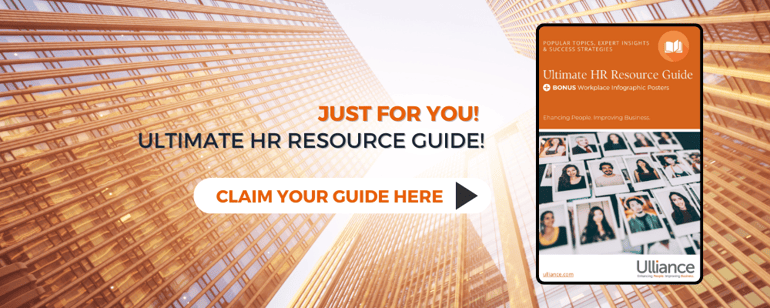As an HR professional, your job isn't just about paperwork and policies. It’s about navigating complex people issues, ensuring compliance, and fostering a culture where employees thrive.
With all the challenges on your plate, it’s crucial to have a solid foundation of the most important HR rules. Whether you’re dealing with employee disputes or making sure the organization stays out of legal hot water, these essentials will guide you in creating a positive and productive work environment.
Important Human Resources Regulations & Rules
HR practitioners are expected to understand dozens of regulations, rules, policies, and best practices - from workplace discrimination laws to regulations governing employee benefits.
While not exhaustive, the sections below outline some of the most important rules and regulations.
Employee Benefits
Employee benefits are a significant part of what makes an organization competitive, and ensuring these benefits comply with regulations is a key HR responsibility. Employees should know what they are entitled to, and HR must ensure those benefits are well-documented and communicated clearly.
- The Family and Medical Leave Act (FMLA) requires employers to provide eligible employees with up to 12 weeks of unpaid, job-protected leave annually for specific family and medical reasons. This includes circumstances such as the birth and care of a newborn child, adoption or foster care placement of a child, and caring for an immediate family member with a serious health condition. Additionally, employees can take leave for their own serious health condition that makes them unable to perform their job duties.
- COBRA (Consolidated Omnibus Budget Reconciliation Act) enables employees and their families to maintain their health insurance coverage for a limited period after leaving employment, whether due to job loss, reduction in hours, transition between jobs, or other qualifying events. This law applies to group health plans maintained by employers with 20 or more employees. Under COBRA, eligible individuals can continue coverage for themselves and their dependents for up to 18 months, with some circumstances allowing for extensions up to 36 months.
- The Employee Retirement Income Security Act (ERISA) establishes standards for private employer-sponsored retirement and health plans. This federal law is designed to ensure transparency in the management of these plans and imposes fiduciary responsibilities on employers to safeguard employee benefits, thereby protecting the interests of workers and their families.
- Certain employers are mandated by the Affordable Care Act (ACA) to offer health insurance that aligns with specified minimum standards of coverage and affordability. This requirement primarily targets employers with 50 or more full-time equivalent employees - who must provide coverage that is reasonably priced and includes essential health benefits, such as emergency services, preventative care, maternity and newborn care, mental health and substance use disorder services, and prescription drugs.
- The Health Insurance Portability and Accountability Act (HIPAA) establishes national standards for the protection of sensitive patient data, ensuring that personal health information (PHI) is kept confidential and is used only for authorized purposes. Additionally, HIPAA includes provisions that help individuals maintain their health insurance coverage when transitioning between jobs.
- Paid sick leave benefits are often governed by state and local laws, which may require employers to provide a certain amount of paid time off for employees to take care of their health needs or to recover from illness. These requirements can vary significantly depending on the jurisdiction, including the amount of leave allowed, the eligibility criteria for employees, and the specific circumstances under which paid sick leave can be used, such as for personal illness, caring for a family member, or attending medical appointments.
- HR should ensure employees feel comfortable reporting illegal activities or unsafe conditions without fear of retaliation, in accordance with various whistleblower protection laws. Clear policies and reporting channels are crucial for compliance.
- Beyond HIPAA, HR must ensure that employee data is handled in compliance with privacy regulations, such as the European Union’s General Data Protection Regulation (GDPR) (which applies to some firms in the US) or the California Consumer Privacy Act (CCPA), especially when dealing with sensitive personal information.
Proper handling of these benefits prevents potential legal issues and fosters trust between employees and management.
Employment laws and compliance
Understanding and complying with employment laws is non-negotiable, and it forms the backbone of responsible HR management. Employment laws encompass various regulations that govern fair treatment, wages, hours, and workplace safety.
4 Crucial Employment Laws:
1. Fair Labor Standards Act
The Fair Labor Standards Act (FLSA) sets standards for minimum wage, overtime pay eligibility, recordkeeping, and child labor. Compliance with these requirements helps ensure that employees are treated fairly and paid appropriately for their work.
2. Equal Employment Opportunity (EEO)
Equal Employment Opportunity (EEO) laws are designed to prevent discrimination in the workplace. These laws ensure that all employees have equal opportunities regardless of race, gender, age, religion, or disability. HR must ensure that hiring, promotion, and employment practices are free from bias and discriminatory practices. They include:
○ Title VII of the Civil Rights Act
○ Age Discrimination in Employment Act (ADEA)
○ Americans with Disabilities Act (ADA)
3. National Labor Relations Act (NLRA)
The National Labor Relations Act (NLRA) protects employees' rights to organize and to engage in collective bargaining. It’s crucial for HR professionals to understand how this law impacts union and non-union workplaces, ensuring that employees can exercise their rights without fear of retaliation.
4. OSHA-Occupational Safety and Health Act
OSHA requires employers to provide a safe workplace. This means implementing safety protocols, providing necessary training, and ensuring that workplace hazards are mitigated. Compliance with OSHA not only avoids penalties but also promotes a culture of safety and care for employee well-being.
HR is required to ensure that mandatory labor law posters are displayed prominently in the workplace, informing employees of their rights under various regulations. Compliance with posting requirements is essential to keep employees informed and avoid penalties.
In addition to being part of employee benefits, the Family and Medical Leave Act also plays a key role in compliance by mandating job-protected leave for eligible employees. Understanding the detailed eligibility requirements and ensuring accurate recordkeeping are critical for compliance.
Regular training, robust policies, and consistent application help in staying compliant and creating a supportive environment.
Employee classification and wage compliance
Employee classification is a foundational responsibility for HR. Misclassifying employees can lead to severe financial and legal consequences, including fines, back wages, and penalties.
Independent Contractors vs. Employees
One of the most common misclassification issues is incorrectly labeling an employee as an independent contractor.
Independent contractors typically have more control over how they complete their work, provide their own tools, and often work for multiple clients. In contrast, employees are subject to the direction and control of the employer regarding what tasks are performed and how.
Misclassifying employees as contractors can lead to violations in tax reporting, benefits provision, and labor law compliance.
Exempt vs. Non Exempt Employees
Another crucial classification involves determining whether an employee is exempt or non-exempt from overtime under the Fair Labor Standards Act (FLSA).
Exempt employees are typically salaried and do not qualify for overtime pay, provided they meet certain criteria related to their duties and salary thresholds. Non-exempt employees, however, must be paid overtime for hours worked over 40 in a workweek.
Misclassifying a non-exempt employee as exempt can lead to significant back pay obligations and penalties for unpaid overtime.
Terminations
HR must comply with termination laws governing final pay timelines, notice requirements, and unemployment compensation. Proper handling of terminations, including documentation and adhering to state-specific regulations, is vital to prevent legal issues.
Workplace safety and health standards
OSHA (Occupational Safety and Health Administration) regulations require employers to create a workplace free from recognized hazards that could cause injury or illness.
HR must ensure that all safety protocols are well-established and communicated effectively, and that employees are properly trained to understand and follow them. This includes training on hazard identification, emergency response, and safe work practices. Regular safety audits should be conducted to identify potential risks and address them proactively before they lead to incidents.
Beyond safety training, HR should ensure that other mandatory training, such as sexual harassment prevention, is conducted as required by state or federal laws. Regular training helps maintain compliance and promotes a healthy work environment.
A healthy workplace also involves mental well-being. HR should ensure that the organization provides access to wellness programs, mental health resources, and stress management initiatives. A proactive approach to mental health can involve offering Employee Assistance Programs (EAPs), conducting workshops on stress management, and promoting work-life balance.
HR's Role in Ensuring Compliance
HR professionals play a crucial role in not only understanding these regulations and rules but also ensuring that all other departments, managers, and employees are aware of their responsibilities.
To maintain compliance across the organization, HR must engage in regular training sessions, provide accessible resources, and communicate updates on regulations effectively.
Managers should be well-equipped to understand and implement HR policies, while employees must be informed about their rights and responsibilities. By fostering awareness throughout the organization, HR helps create a culture of compliance, respect, and proactive risk management.

When you partner with Ulliance, our Life Advisor Consultants are always just a phone call away to teach ways to enhance your work/life balance and increase your happiness. The Ulliance Life Advisor Employee Assistance Program can help employees and employers come closer to a state of total well-being.
Investing in the right EAP or Wellness Program to support your employees will help them and help you. Visit https://ulliance.com/ or call 866-648-8326.
The Ulliance Employee Assistance Program can address the
following issues:
• Stress about work or job performance
• Crisis in the workplace
• Conflict resolution at work or in one’s personal life
• Marital or relationship problems
• Child or elder care concerns
• Financial worries
• Mental health problems
• Alcohol/substance abuse
• Grief
• Interpersonal conflicts
• AND MORE!
References:
HR Rules You Need to Know; PeopleKeep; Chase Charaba
https://www.peoplekeep.com/blog/hr-rules-you-need-to-know
The Fundamentals of HR Employment Law for Compliance; Tulane University Law School
https://online.law.tulane.edu/blog/employment-law-and-hr-understanding-the-basics-and-staying-compliant
Laws and Regulations Every HR Professional Should Know; Northeastern University Graduate Programs; Shayna Joubert
https://graduate.northeastern.edu/resources/hr-laws-to-know/


